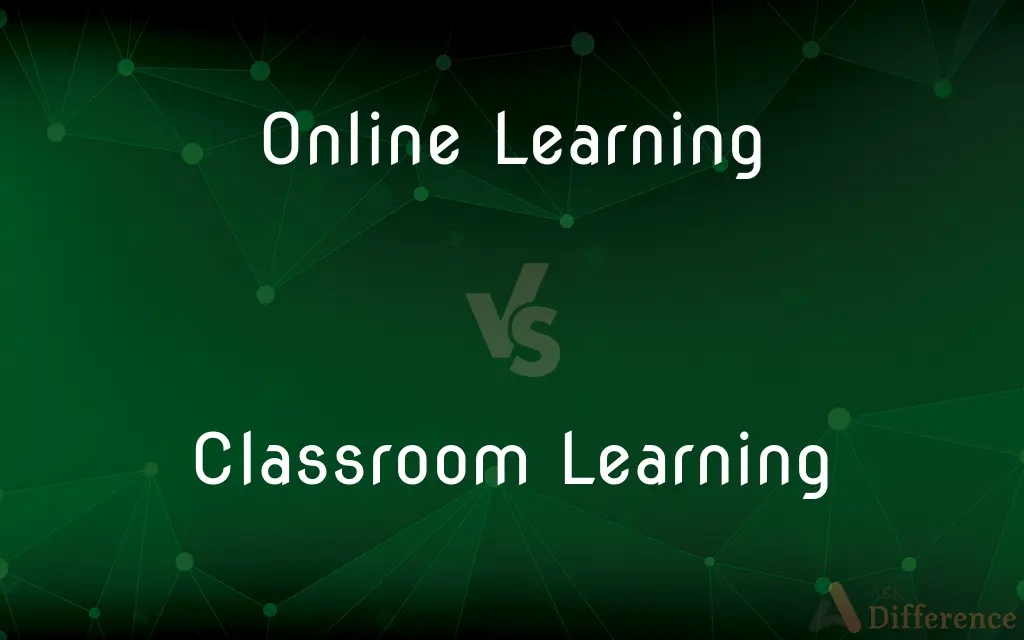Online Learning vs. Classroom Learning — What's the Difference?
By Tayyaba Rehman — Published on November 11, 2023
Online Learning provides education via digital platforms remotely, while Classroom Learning involves traditional, in-person instruction.

Difference Between Online Learning and Classroom Learning
Table of Contents
ADVERTISEMENT
Key Differences
Online Learning indicates educational activities that utilize digital platforms and technology to facilitate remote access to learning materials and instruction. Classroom Learning typically refers to a traditional form of education where instruction and learning take place in a physical location, with direct interaction between educators and students.
With Online Learning, students may access their coursework at any time, offering flexibility and convenience. In contrast, Classroom Learning often follows a set schedule, with predetermined times for classes, providing a structured and consistent routine.
The environment for Online Learning is virtually based, allowing students to participate from anywhere with internet access. Conversely, Classroom Learning necessitates a physical presence, which can foster direct social interaction and immediate feedback from instructors.
Online Learning often necessitates a higher degree of self-motivation and discipline due to the flexibility it offers. Classroom Learning, on the other hand, may naturally enforce discipline due to its structured schedule and the physical presence of educators and peers.
The technological requirements for Online Learning are typically more demanding, requiring reliable internet access and compatible devices. Classroom Learning primarily demands physical attendance, with technology acting as a supplementary tool rather than a necessity.
ADVERTISEMENT
Comparison Chart
Location
Remote, anywhere with internet
Physical, specific location
Interaction
Virtual, through digital platforms
Direct, in-person
Schedule Flexibility
High, often self-paced
Low, fixed schedule
Social Aspect
Limited, virtual interactions
Robust, direct interactions
Technological Dependence
High, requires devices and internet
Low, mainly requires physical attendance
Compare with Definitions
Online Learning
It allows students to access learning materials remotely via the internet.
Sarah appreciated Online Learning because she could review lectures whenever she wanted.
Classroom Learning
Classroom Learning facilitates immediate feedback and direct social interactions.
The instant feedback during Classroom Learning helped Mia improve her language skills quickly.
Online Learning
Online Learning is education facilitated through digital platforms.
John completed his degree through Online Learning, never having to attend a physical campus.
Classroom Learning
It follows a structured schedule with predetermined class times.
Lily had to attend her Classroom Learning sessions every Monday and Wednesday at 9 AM.
Online Learning
Online Learning may encompass both synchronous and asynchronous instructional methods.
Online Learning enabled Bob to watch live webinars or recorded sessions as per his availability.
Classroom Learning
It often involves group activities, discussions, and collective learning experiences.
During his Classroom Learning, Alex often engaged in group discussions and collaborative projects.
Online Learning
Online Learning provides flexibility in scheduling and pacing of education.
Through Online Learning, Emily could work full-time while pursuing her studies.
Classroom Learning
Classroom Learning occurs in a physical location with direct interaction between teachers and students.
Jake enjoyed Classroom Learning because he could ask questions in real-time.
Online Learning
It often requires a significant level of self-discipline and self-direction.
In his Online Learning program, Mark had to motivate himself to meet deadlines.
Classroom Learning
Classroom Learning provides a conventional and socially immersive educational environment.
Classroom Learning allowed Nina to form study groups and socialize with her peers.
Common Curiosities
Can Online Learning accommodate different time zones?
Yes, especially asynchronous learning, which doesn’t require simultaneous online presence.
How can Classroom Learning support students’ immediate queries?
Through direct, real-time interactions with instructors and peers.
What is the primary advantage of Online Learning?
Flexibility in schedule and accessibility from various locations.
Does Online Learning require specific technology?
Yes, a reliable internet connection and compatible device are typically necessary.
Are there limitations to the accessibility of Classroom Learning?
Yes, factors like location, mobility, and scheduling can limit accessibility.
How does Classroom Learning enhance student interaction?
Through direct, in-person communication, and group activities.
Can Online Learning accommodate a variety of learning styles?
Yes, through diverse online content like videos, readings, quizzes, and forums.
Is social interaction limited in Online Learning?
It's different and may be limited but can be facilitated through forums, chats, and online meetings.
What supports are typically available in Online Learning?
Supports might include virtual office hours, email correspondence, and online resources.
How does Classroom Learning impact social development?
It provides environments for direct social interactions, group work, and networking.
Can Online Learning facilitate practical skills development?
To an extent, through virtual labs and simulations, but some limitations exist.
Is Classroom Learning effective for theory-intensive subjects?
Yes, with direct interactions, discussions, and immediate clarification, it can be very effective.
Can both Online Learning and Classroom Learning provide quality education?
Yes, quality can be upheld in both modes when effectively designed and implemented.
How does Classroom Learning cater to practical skill-building?
Through in-person labs, workshops, and hands-on activities.
Can both Online Learning and Classroom Learning coexist in hybrid models?
Absolutely, hybrid models can combine the strengths of both learning modes.
Share Your Discovery

Previous Comparison
Golgi Bodies vs. Mitochondria
Next Comparison
Physical Properties vs. Chemical PropertiesAuthor Spotlight
Written by
Tayyaba RehmanTayyaba Rehman is a distinguished writer, currently serving as a primary contributor to askdifference.com. As a researcher in semantics and etymology, Tayyaba's passion for the complexity of languages and their distinctions has found a perfect home on the platform. Tayyaba delves into the intricacies of language, distinguishing between commonly confused words and phrases, thereby providing clarity for readers worldwide.












































